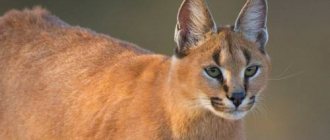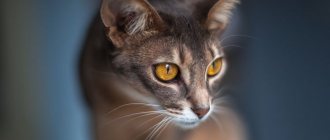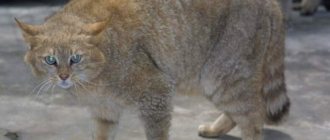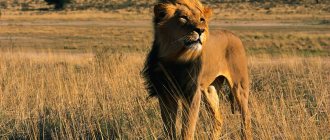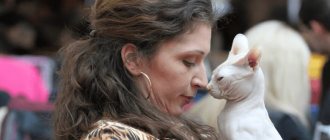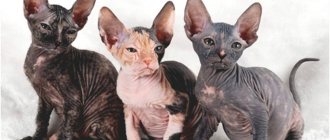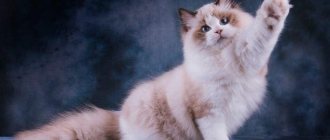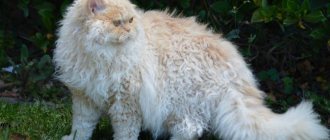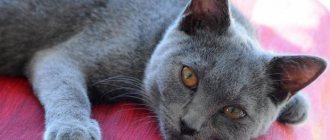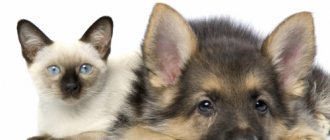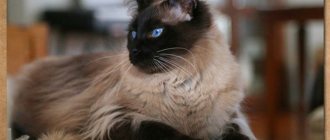Cat with round ears: Breed
Some time ago, photos of cats with rounded ears appeared on the Internet, which are very similar to cartoon mouse ears. These pictures simply blew up the Internet, users wanted to know what this new exotic breed was.
But, to the disappointment of many, it turned out that these cats are just a high-quality photoshop, and in fact such a breed does not exist.
There are only cats with more or less rounded ears. These include:
- Persian cats.
- Exotics (similar to Persians, but larger eyes).
- American Curls. Their ears bend back and look round.
To enlarge the picture, click on it
Why does a cat have big ears?
A very common misconception is that the larger the ears a cat has, the better it can hear. Nothing of the kind: the size of the auricle in no way affects the acuity of a cat's hearing. Cats with small ears have just as good hearing as cats with large ears.
Big ears on a cat are beautiful
This anatomical feature has a purely utilitarian explanation - it is a unique and quite effective cooling system. Initially, it is inherent in those cat breeds that are of eastern or southern origin - the regulation of heat exchange is especially important for them.
A huge number of capillaries are concentrated in the auricle. Passing through these vessels, the blood is cooled to the optimal temperature, which helps the cat avoid unnecessary overheating. In hot weather, blood circulation occurs faster, in cool weather - slower. That's the whole secret.
Large ears help a cat regulate its temperature balance
Eared cats look funny and unusual. Breeders cultivate this feature solely for the sake of breed marketing - exotic appearance stimulates sales. Therefore, it is difficult to say that super ears are so necessary for modern cats to live a normal life. On the other hand, this doesn’t really bother them.
Cat breed with round ears: Wild houses
In addition to true domestic cats, hybrids of domestic and wild cats: servals and savannahs have rounded ears. These exotic representatives are no longer so rarely seen in cities as pets.
We must understand that their character and needs are closer to those of their ancient ancestors , who bloodthirstyly dealt with their victims. That's why cats and predators.
It is also worth considering that it is not recommended to keep such pets in a one-room apartment.
They need a separate corner or even a room. In addition to the high price for such rare cats, the peculiarity is that they need more food than an ordinary domestic cat.
To enlarge the picture, click on it
Contrary to many opinions, the diet should not consist of proteins alone. The food must have a balance of fats, carbohydrates, proteins and minerals.
The cat must be provided with exercise. Walk with her on the street or create a play complex with the ability to sharpen her claws, jump and run. Otherwise, the fluffy beauty will begin to take out her needs on curtains, furniture, wallpaper and other things of the owner.
Regarding health, the recommendations are the same as for ordinary cats. Regular vaccinations and dewormings.
A medical examination is also required once a year. If you do not plan to breed, then it is better to sterilize the cat in order to avoid health problems, active manifestation of rutting and marks.
Watch the video: Amazing pet with mouse ears - American Curl
If you liked our article, read other materials about cat health on the Guardian of Purity website. Dog owners are also welcome! To do this, go to the appropriate section.
The resource also publishes information about cleaning apartments, offices, industrial premises, home and specialized household appliances, washing and stain removal.
Share articles by clicking on the buttons of your favorite social networks. Stay with us!
Causes of irregularly shaped ears in cats
The cause of abnormal ear structure is a mutation gene, and it is different for each breed. For example:
- Scottish Fold gene is a dominant lop ear gene with partial penetrance. Representatives of pets with this mutation have ears that “look” forward. Moreover, the degree of fit of the ears varies. The gene for fold-eared breeds is also associated with limb defects: in parallel with “wrong” ears, changes occur in the cat’s skeleton. Because of this, breeders stopped crossing two individuals of Scottish Folds with each other, thereby eliminating animal health problems.
- American Curl gene. With this mutation, the cat’s ear begins to “curl” towards the upper tip. The ear can be turned up to 180 degrees. This gene does not have a negative effect on the development of the cat and its health.
- Round ears. As a result of the predominance of the mutating gene, the animal has not the traditional triangular shape of the ears, but a round one. This “defect” was first discovered in pets in Italy, and later in America.
Balinese (Balinese) cat
Photo: Instagram: @tishenko.knit
It is believed that representatives of this breed also have large ears, although their breeders do not agree with this opinion: they say they have bigger ones. Experts believe that the breed arose due to a spontaneous gene mutation of Siamese cats (Balinese have a typical color). The breed is named after the Bali dancers, who have a flexible and wiry body. But, compared to them, cats also have a fluffy tail, more like a luxurious train.
Cat breeds with abnormal ear structure
There are eight breeds of cats in which the structure of the ears differs from the usual standard shape. These breeds include:
- Scottish fold. Today this breed is the most common. It was developed in the 20th century in Scotland. The appearance of cats is quite unusual; they resemble small owlets due to their curled ears and large eyes. Due to a mutation, Scottish cats have two types of ears: forward-curved (called Scottish Folds) and straight (Scottish Straights). For many years, geneticists prohibited the breeding of this breed due to the accompanying health problems, but the problem was solved. During breeding, Scottish Folds were crossed only with Scottish Straights. As a result of such mixing, the gene for lop ears remained, and hereditary diseases disappeared.
- Highlander is a cat breed bred in America in the nineties of the twentieth century. Breeders crossed the jungle curl and the desert lynx. The result was a cat with a beautiful spotted color, a small tail and curled ears. This breed was officially recognized by the International Cat Association in May 2008. Fans of unusual breeds are happy to purchase Highlanders.
- The American Curl is a relatively new breed, originally from the USA. Pets have an interesting ear structure; they curl outward. It is noteworthy that kittens are born with straight ears, but after a week they begin to curl up. The American Curl was recognized only in 1983. At the same time, standards for this breed and a breeding plan were developed. In the late 90s, Roy Robinson, a British breeder, wrote an article stating that, apart from curled ears, no genetic disorders were observed in bred Curl kittens. And unlike other breeds that take decades to be recognized, the American Curl has been accepted by the International Cat Association.
- Peterbald (St. Petersburg Sphynx) is a Russian breed, bred in 1994 by Olga Mironova. A Russian felinologist crossed an oriental cat and a Don Sphynx. The result was a hairless pet with big ears. The beautiful St. Petersburg Sphynx received recognition from the Breeding Felinological Federation in 1996. At the end of the twentieth century, Peterbald gained worldwide recognition. To date, crossbreeding work continues.
- Ukrainian Levkoy - the breed was bred in 2004 by felinologist E.V. Biryukova. She crossed the Don Sphynx with the Scottish Fold. In 2007, a nursery for Levkoys was opened in Russia. A distinctive feature of the breed is the appearance of the ears, which are located high and slightly curved towards the head. This breed is becoming increasingly popular in the modern world.
- The Elf is a breed native to North America. In 2006, this breed was developed by two breeders Kristen Lead and Karen Nelson. They crossed the Canadian Sphynx and the American Curl. The result was a beautiful hairless cat with large curved ears, like an elf. Hence the name. Pets have good health and endurance. Since selection work is still ongoing, the breed has not been officially recognized by any phenological organization.
- Oriental cats were bred by American breeders in the 60s. By crossing a Balinese cat and an Oriental shorthair, breeders were able to create this amazing cat. For the first time, the elegant beauty was presented at competitions in 1977 as an independent breed. But long-eared cats were officially recognized in 1997 by the GCCF association. The Oriental cat is similar to the Siamese breed, only its ears are much larger.
- Kinkalow - in 1997, American breeder Terry Harris crossed an American Curl with a Munchkin. As a result of this crossing, kittens were born with two different mutations - short legs and curved ears, a long tail and a massive body. In 2008, the Kinkaloo was recognized by the Dwarf Cat Association. Today, representatives of this breed can be seen mainly in America.
Each of the above breeds has its own advantages and disadvantages. But they all have one thing in common - the “wrong” structure of the ears. Some people are attracted and impressed by this feature, while others are repulsed. In any case, cats, despite their body structure, remain affectionate and gentle favorites for their owners.
Oriental cats
The Oriental cat is one of the most popular and promising breeds. They are the closest relatives of the most famous oriental breed - the Siamese. These are graceful, graceful cats of a thin build with long legs, a wedge-shaped muzzle and large pointed ears.
Each breed of animal is determined by specific features in appearance and character traits that are unique to it - this is called the breed standard, which must be recognized by various organizations of felinologists (TICA, FIFe, WCF, CFA, IFA, ICU, WACC, etc.) for each of them own rules of recognition. All purebred cats are given pedigrees.
American Curl
This breed of cats with round ears is now at the peak of popularity; besides, the pets themselves have not only an unusual appearance, but also a friendly disposition, they are very sociable, devoted to their owner, and play with pleasure. Distinctive features of the appearance of these animals are as follows :
- Elegant graceful physique.
- Flexible long tail (its length matches the size of the body).
- The average weight is small - 5-7 kg (males), 4-5 kg (females).
- The coat can be either long or short, with long-haired Curls being the most popular among breeders.
But the most striking detail of the pets’ appearance is their rounded, curved ears, the unusual shape of which is explained by a mutation of the hard ear cartilage. In the photo you can see that the inclination of the shell is individual for each cat, it can be 180°, or it can have a more modest value - 90°. A characteristic feature of the breed is that the round tip should not exceed 1/3 of the ear. One of the difficulties faced by pet owners is the fragility of the ear cartilage, so you need to be very careful with your pet.
Cats with mouse ears
Call a veterinarian to your home
Someone picks up cats on the street, completely free of charge. Others buy them at the market for symbolic...
Do not own these cats under any circumstances! The most evil cat breeds
The cat is one of the most common pets. She is able to give affection, warmth and love. But…
Scottish Fold / Interesting facts about cats
Hello friends. Today we will talk about Scottish fold cats. https://www.kotishka-n.ru/porody-koshek/515-shotlandskaya-vislouha…
10 MOST DANGEROUS CAT BREEDS
Win a trip: https://goo.gl/ZMCRhu Official online store: https://goo.gl/NCk13z 10% DISCOUNT on all smartphones: BUBBLE…
ELVEN EARS, GOOD CHARACTER. ORIENTAL CATS
ELVEN EARS, GOOD CHARACTER. ORIENTAL CATS Oriental cats in Yekaterinburg. Cats with heterochromia...
Cat breeds with curled ears are Curls. Curl cats - funny animals.
The main feature of the breed is its curved ears, which have funny names, for example...
xn—-7sbhmmwjip0a7h.xn--p1ai
Scottish Fold
Another cat with round ears is called the Scottish Fold. This is a very cheerful and friendly animal that does not require special care. The characteristics of the breed are :
- Medium-sized body with thick, pleasant-to-touch, plush-like fur.
- The head has a rounded muzzle and round whisker pads.
- The wide-set ears have an unusual shape - their upper part is bent so that it hides the pinna.
- Round big eyes. We allow them to have different colors, but they must match the color of their coat.
- The nose is wide.
- The tail is medium in size, tapering towards the end.
The round shape of the ears is the result of a genetic mutation in the simplest domestic cat. Animals with good care can live up to 15 years, but owners should remember two weak points of the breed. These are diseases of the joints (the tail is especially dangerous) and the heart. Cats are also prone to overeating.
Canadian Sphynx
One of the oldest breeds, which has won the hearts of people with its more than extraordinary appearance - an elongated, “faceted” muzzle, bare “velor” skin, the intelligent look of lemon-shaped eyes and huge ears, like those of a bat. The first “officially described” Sphinx lived in Ancient Egypt. A white blue-eyed cat guarded the Sanctuary of Ancient Egypt.
The Don and Petersburg (Peterbald) sphinxes are also “noble eared animals” with a naked body, although they are not relatives of the “Canadians”. Both breeds were developed in Russia, and the Peterbald was created by crossing the Don Sphynx and the Oriental cat.
Hairless cats have a “dog-like disposition” and require special care. Contrary to popular belief: “no hair, no problem,” caring for Sphynx cats is more problematic than caring for Angora or Persian cats. Daily skin cleansing, strictly balanced nutrition and clothing that protects the cat from hypothermia. The Sphinx is a child in need of care with the look of a sage and the appearance of an alien creature.
More information about the Canadian Sphynx breed
Ukrainian Levkoy
Representatives of the breed have rounder ears than the Scots. In the photographs you can see that their appearance is very unusual: they have large round ears and a complete absence of hair.
To develop the breed, Don Sphynxes, Scottish Folds, Orientals, Peterbalds and domestic cats were used. Due to such a rich list of ancestors, the Ukrainian Levkoy got its original appearance. The name of the breed was given by the gillyflower, which is distinguished by its external resemblance to the downward curved small round ears of such cats. The animal's traits are :
- Muscular body of medium size. Weight – about 5 kg.
- The eyes are large, almond-shaped. Preferred colors are blue, green.
- The skin is covered with numerous folds and is always hot.
- Ears with rounded tips are set high.
They are distinguished by a pliable disposition, sociable, intelligent and quick-witted, devoted to their owner and very affectionate.
List of breeds with large ears and elongated muzzles
This list is quite large. It consists predominantly of animals of Asian or African origin. It also included several artificially created breeds with an exotic appearance.
The most popular cats with large ears and elongated muzzles are:
- Maine Coon;
- Somalia;
- oriental;
- Siamese;
- Canadian Sphynx;
- Ukrainian Levkoy;
- Abyssinian
Maine Coon
This popular cat breed with large ears and a long muzzle is distinguished by its impressive size. The weight of an adult can reach 12-15 kg. The Maine Coon's elongated, large body is covered with thick, semi-long hair with developed decorative hair.
The main distinguishing feature of these cats with long muzzles is their large ears with neat fluffy tufts at the tips.
Despite its impressive dimensions, you can keep a cat of this breed not only in a house, but also in an apartment. Although large Maine Coons may appear clumsy, they move with stunning grace.
In addition to their amazing appearance, fluffy long-eared cats with an elongated muzzle are endowed with a good-natured, affectionate disposition. Calm and patient representatives of the breed love to play and need the care of their owner.
Somalia
These floppy-eared cats are bred based on the Abyssinian. They received official recognition in the 70s of the last century.
The Somali's graceful body is covered with luxurious, elongated fur of a ticked reddish hue. But the main distinguishing feature of representatives of this breed is their elongated muzzle and movable large ears.
The shell, widened at the base, is cup-shaped. It gradually tapers to the ends, which can be decorated with fluffy tassels.
Oriental
This sophisticated, graceful cat with large ears was bred in the 60s of the last century. Kittens of this breed were obtained by crossing Siamese with short-haired individuals of a single color. Orientals are easy to recognize by their graceful, flexible body and beautiful head with a long muzzle.
The triangular large ears, reminiscent of fans, are considered to be a kind of calling card of the representatives of the breed. Slender, thin cats are covered with short hair of almost any color.
Highlander
A new breed, the Highlander, also has round ears. These are very unusual animals of an exotic species, which also have the name “mountain lynx”. However, among the ancestors of these cats there were no dangerous predators; their ears are slightly curved back, and their muzzle in its expression resembles a trot. The distinctive features of the breed are:
- Powerful muscular body.
- Short tail.
- The eyes are large and round in shape.
- The acceptable colors are varied, the standard recognizes the presence of 1-2 colors, as well as color point colors.
Cats with round ears are diverse, among them there are long-haired and short-haired, large, medium and small in size, but they all look bright, unusual and attractive.
Abyssinian cat
A breed with an original savannah color, black eye rims, short hair and a strong, muscular body. Large, pointed and very mobile ears help the “Abyssinian” to be itself – a hyperactive, playful, restless pet. While the lazy Persian stretches out on the sofa, suffering from the heat, the “Abyssinian” is always cheerful and cheerful.
Read more about the Abyssinian cat breed
All cat breeds
Cats have been known to mankind for at least 10,000 years; they have been highly valued by people at all times not only for their ability to catch rodents (catching mice is especially important at home), but also for their innate ability to bestow people with their affection.
10,000 years of love and benefit
Scientists have found that all modern cat breeds come from the steppe cat, which was domesticated by humans. This happened at different times in different parts of the world, so data may vary depending on the region. However, despite the fact that domestication occurred on average 10,000 years ago, cats have almost completely retained the ability to go wild. And this is combined with the enormous love for a person that they are able to show.
Features of care
When caring for big-eared cats, you must first take into account the characteristics of the breed to which they belong. But proper ear care is extremely important for all “mouse cats” - after all, the larger the ears, the more problems can arise with them.
Each breed has its own maintenance nuances, but ear care is the same for all cats.
Ear hygiene
Cleanliness, as they say, is the key to health. Timely and high-quality hygiene of cat ears is the prevention of infection, and, consequently, various serious diseases. Check your pet's ears regularly and contact your veterinarian immediately if the following symptoms appear:
- redness and itching;
- swelling;
- unpleasant odor;
- painful sensations.
If you have any problems with your ears, contact your veterinarian.
For preventive care at home, you should choose a ready-made product for this purpose - the choice of ear drops is quite large. The use of alcohol, peroxide and other homemade products can lead to irritation and even burn the delicate surface of the ear.
Contamination and the occurrence of inflammatory processes can be caused by hairs growing too densely inside the ear - they must be removed, but only very carefully so as not to cause pain and discomfort to the animal.
The cat's ear should be clean and free of excess hairs.
Before proceeding directly to the procedure of cleaning the ears, it is recommended to do a light massage - lightly rub and knead the ears for five to ten seconds. Then give the cat a couple of minutes to shake its head - this will cause the softened wax to come out of the ear canals. Wipe it with cotton pads or swabs soaked in ear cleaning fluid, but be sure to use different swabs for your ears. Try not to go deep into the ear canal.
Ear cleaning is a regular and responsible process.
